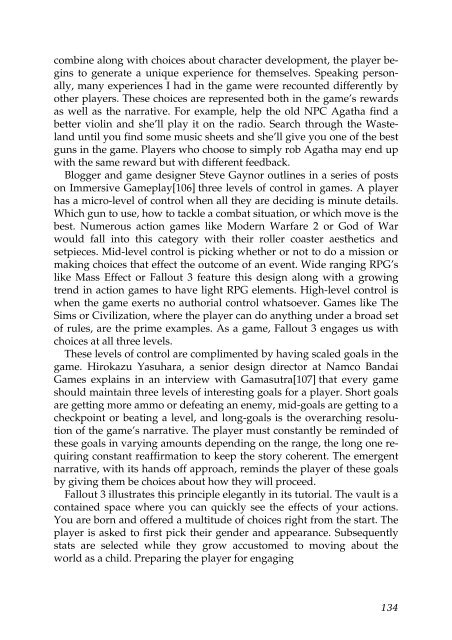Well Played 2.0: Video Games, Value and Meaning - OpenLibra
Well Played 2.0: Video Games, Value and Meaning - OpenLibra
Well Played 2.0: Video Games, Value and Meaning - OpenLibra
Create successful ePaper yourself
Turn your PDF publications into a flip-book with our unique Google optimized e-Paper software.
combine along with choices about character development, the player begins<br />
to generate a unique experience for themselves. Speaking personally,<br />
many experiences I had in the game were recounted differently by<br />
other players. These choices are represented both in the game’s rewards<br />
as well as the narrative. For example, help the old NPC Agatha find a<br />
better violin <strong>and</strong> she’ll play it on the radio. Search through the Wastel<strong>and</strong><br />
until you find some music sheets <strong>and</strong> she’ll give you one of the best<br />
guns in the game. Players who choose to simply rob Agatha may end up<br />
with the same reward but with different feedback.<br />
Blogger <strong>and</strong> game designer Steve Gaynor outlines in a series of posts<br />
on Immersive Gameplay[106] three levels of control in games. A player<br />
has a micro-level of control when all they are deciding is minute details.<br />
Which gun to use, how to tackle a combat situation, or which move is the<br />
best. Numerous action games like Modern Warfare 2 or God of War<br />
would fall into this category with their roller coaster aesthetics <strong>and</strong><br />
setpieces. Mid-level control is picking whether or not to do a mission or<br />
making choices that effect the outcome of an event. Wide ranging RPG’s<br />
like Mass Effect or Fallout 3 feature this design along with a growing<br />
trend in action games to have light RPG elements. High-level control is<br />
when the game exerts no authorial control whatsoever. <strong>Games</strong> like The<br />
Sims or Civilization, where the player can do anything under a broad set<br />
of rules, are the prime examples. As a game, Fallout 3 engages us with<br />
choices at all three levels.<br />
These levels of control are complimented by having scaled goals in the<br />
game. Hirokazu Yasuhara, a senior design director at Namco B<strong>and</strong>ai<br />
<strong>Games</strong> explains in an interview with Gamasutra[107] that every game<br />
should maintain three levels of interesting goals for a player. Short goals<br />
are getting more ammo or defeating an enemy, mid-goals are getting to a<br />
checkpoint or beating a level, <strong>and</strong> long-goals is the overarching resolution<br />
of the game’s narrative. The player must constantly be reminded of<br />
these goals in varying amounts depending on the range, the long one requiring<br />
constant reaffirmation to keep the story coherent. The emergent<br />
narrative, with its h<strong>and</strong>s off approach, reminds the player of these goals<br />
by giving them be choices about how they will proceed.<br />
Fallout 3 illustrates this principle elegantly in its tutorial. The vault is a<br />
contained space where you can quickly see the effects of your actions.<br />
You are born <strong>and</strong> offered a multitude of choices right from the start. The<br />
player is asked to first pick their gender <strong>and</strong> appearance. Subsequently<br />
stats are selected while they grow accustomed to moving about the<br />
world as a child. Preparing the player for engaging<br />
134

















